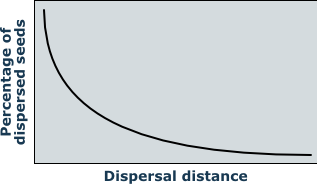Seeds: dispersal
Seed dispersal
Plants are sessile, but their genes move with seeds and pollen. Seeds capable to be dispersed over large distances are important for the colonization of new habitats. Most important are:
- wind transport aided by plumes, wings or a fringe
- seeds with hoes or similar structures to be trapped in animal fur
- carriage in the guts of animals that have eaten berries or hay and which defecate viable seeds
- After seeds have reached the ground, they are frequently moved again by water or by animals.
Most seeds are not dispersed far from the parent (see Table A). The dispersal curve for wind- or animal-dispersed seeds tend to be leptokurtic (Fig. 1).
In habitats of high mountains seed dispersal by wind is most important, followed by running water in little streams or at the soil surface. Small seeds and wind-dispersal are the dominant characteristics of plants from early successional communities (glacier foreland, screes), larger seeds with lower dispersal capacities are more frequent in late successional communities (alpine meadows and shrub communities).
| Short distance dispersal of seeds in glacier foreland species in the Swiss Alps (% of trapped seeds) | ||||
| Frequency of trapped diaspores (%) | ||||
| Dispersal distance from mother plant | 14 cm | 39 cm | 114 cm | 214 cm |
| Trifolium pallescens | 100 | - | - | - |
| Oxyria digyna | 94 | 6 | - | - |
| Linaria alpina | 92 | 5 | 3 | - |
| Achillea moschata | 83 | 17 | - | - |
| Saxifraga aizoides | 68 | 22 | 10 | - |
| Epilobium fleischeri | 32 | 47 | 5 | 16 |
Short distance dispersal of seeds in glacier foreland species in the Swiss Alps (% of trapped seeds). Seeds were trapped with glue on petri dishes arranged in 4 circles with increasing radius around mother plants. % trapped diaspores was calculated from the number of trapped diaspores per circle using a correction factor for increasing perimeter. From Stöcklin and Bäumler 1996.
Long distance dispersal by wind
Wind dispersal spectra are regulated by two plant traits:
- the falling velocity of seeds, and
- diaspore production of shoots.
Using PAPPUS, a mechanistic wind dispersal model (Tackenberg 2003) it was demonstrated that because of more vertical turbulance and convective updrafts, alpine weather conditions are much more favorable for wind dispersal than conditions in the lowland.
Seeds from alpine species with falling velocities up to c. 1.5 ms-1 can be expected to be dispersed effectively by wind; whereas in the lowland falling velocities of c. 0.5 ms-1 are already a threshold value for effective dispersal by wind (Tackenberg and Stöcklin 2008). Some of the seeds of the studied species were dispersed > 100 m, some reached distances > 1000 m. The species best dispersed by wind was Epilobium fleischeri, a pioneer of glacier foreland, with 5 % of the plumed seeds dispersed over distances > 1000 m.
Examples of wind-dispersed species and their seeds


